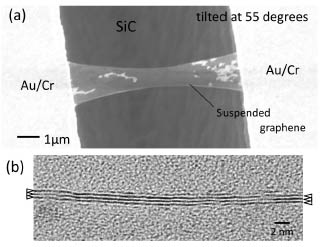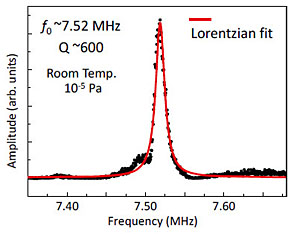Electrochemical Etching Combined with Hydrogen Intercalation
Ā@
Shinich Tanabe, Hiroshi Yamaguchi*, and Hiroki Hibino
Materials Science Laboratory, *Physical Science Laboratory
Graphene is an ideal material for use in nano-electromechanical systems due to its low mass density and exceptional mechanical properties, such as its high YoungĀfs modulus. The fundamental mechanical resonance properties of graphene resonators are now being investigated using systems fabricated from monolayer exfoliated graphene flakes. Exfoliation is a simple way of producing high-quality graphene flakes, but it does not provide good control of the shape and thickness of the graphene. Consequently, there have been few studies on bilayer and trilayer graphene resonators. In this article, we report the creation of trilayer epitaxial graphene resonators through strict control of the number of layers and their mechanical resonance properties.
In this study, we created trilayer epitaxial graphene
resonators by using bilayer graphene epitaxially grown on SiC(0001) substrate
as a starting material [1]. The epitaxial growth method creates a buffer
layer, where carbon atoms are partially bound to silicon atoms of the substrate.
To make the buffer layer into a graphene layer, we decoupled the Si-C bonds
by hydrogen intercalation and performed electrochemical wet etching of
the SiC substrate. These procedures allow us to control the number of layers
precisely. A scanning electron microscopy (SEM) image [Fig. 1(a)] verifies
that the double-clamp graphene beam is suspended between the Au/Cr pads.
A cross-sectional transmission electron microscope (TEM) image [Fig. 1(b)]
shows that the suspended graphene is trilayer. We can thus conclude that
the buffer layer and the bilayer graphene turned into trilayer graphene.
We next investigated mechanical resonance properties of the trilayer graphene.
The amplitude-versus-frequency curve for the trilayer graphene resonator
(Fig. 2) shows the resonant frequency (f0) to be 7.52 MHz and the quality factor to be ~600 at room temperature in a vacuum of 10-5 Pa. However, we calculated f0 to be 0.4 MHz on the basis of standard beam
theory. Another SEM image showed that the resonator has a buckled-shape
deformation. This enhances the stiffness of the resonator, and as a result,
f0 was higher than expected. The inverse of the quality factor, Q-1, of the trilayer graphene showed the typical temperature dependence of
monolayer graphene with a doubly clamped structure. This implies that doubly
clamped graphene resonators have a common mechanism of energy loss irrespective
of the number of layers.
[1] M. Takamura et al., Jpn. J. Appl. Phys. 52 (2013) 04CH01.
Ā@
 |
 |
|||||
|
|